service SSANGYONG KORANDO 2013 Owner's Manual
[x] Cancel search | Manufacturer: SSANGYONG, Model Year: 2013, Model line: KORANDO, Model: SSANGYONG KORANDO 2013Pages: 1336, PDF Size: 92.18 MB
Page 585 of 1336

3. RECOMMENDED FLUIDS AND LUBRICANTS
Use only Ssangyong genuine fluids. Use of non-recommended products could cause damage to
the unit
Keep the specified capacity and service interval. -
-
Page 586 of 1336
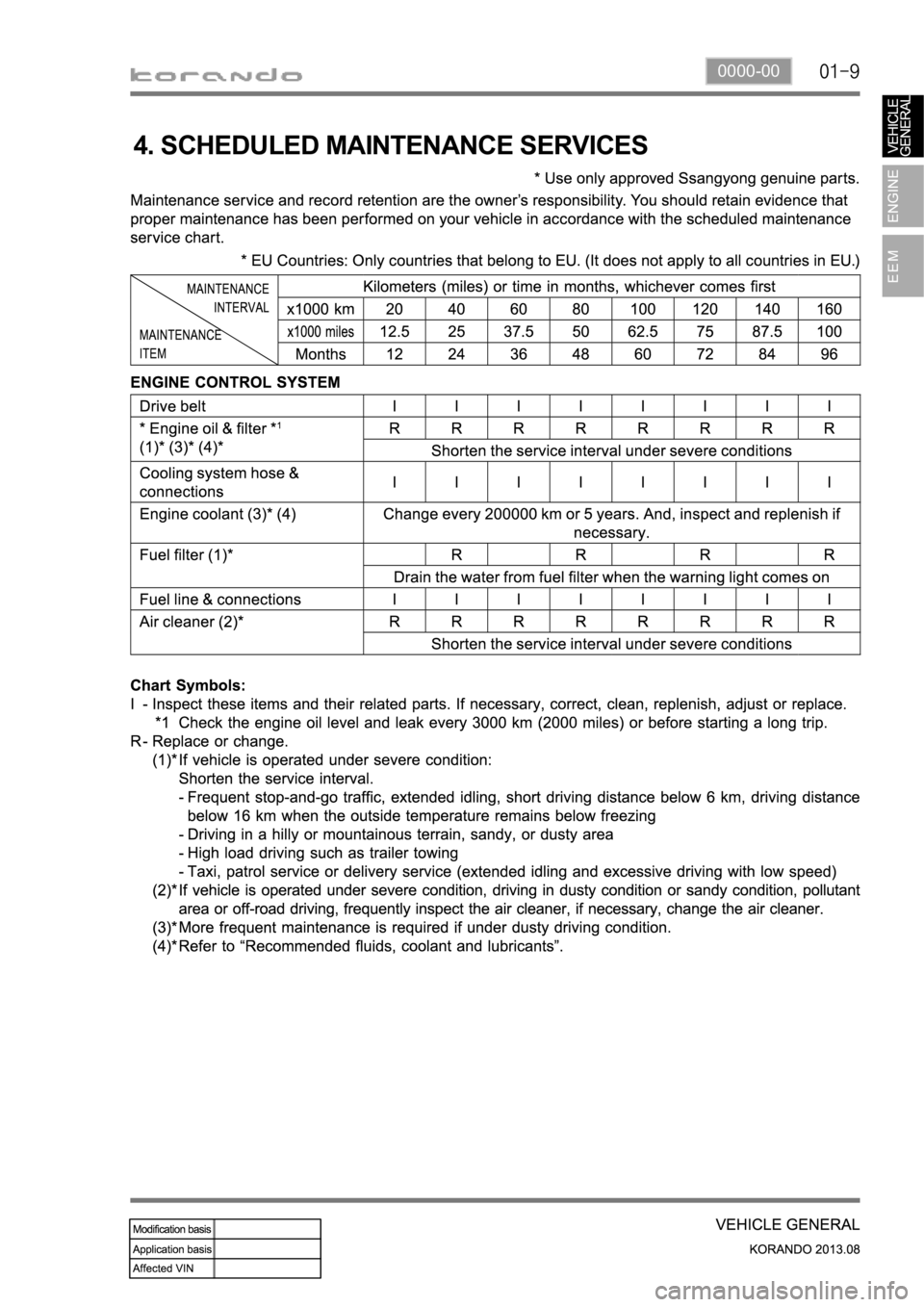
0000-00
4. SCHEDULED MAINTENANCE SERVICES
Page 590 of 1336
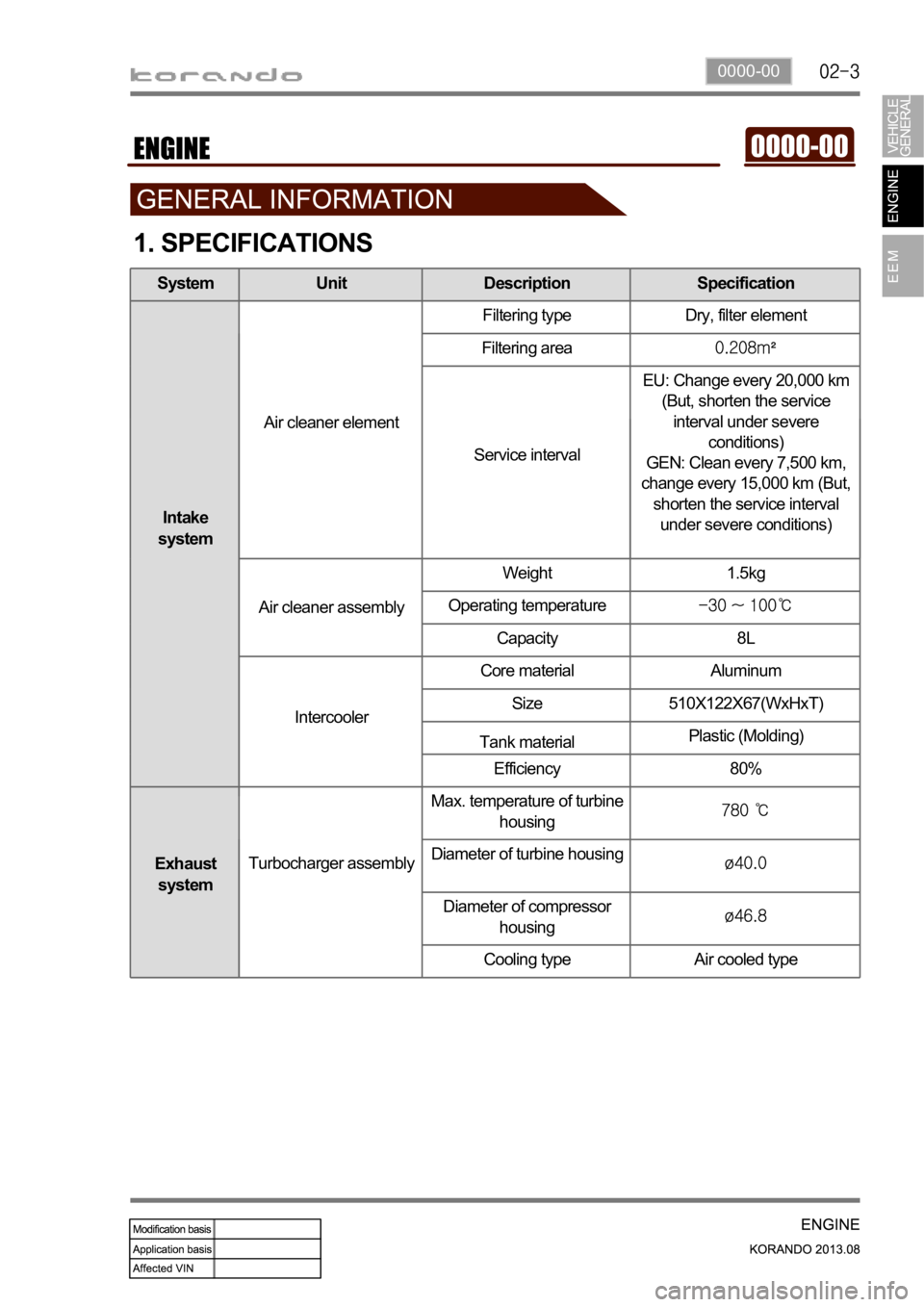
0000-00
1. SPECIFICATIONS
System Unit Description Specification
Intake
systemAir cleaner elementFiltering type Dry, filter element
Filtering area
Service intervalEU: Change every 20,000 km
(But, shorten the service
interval under severe
conditions)
GEN: Clean every 7,500 km,
change every 15,000 km (But,
shorten the service interval
under severe conditions)
Air cleaner assemblyWeight 1.5kg
Operating temperature
Capacity 8L
IntercoolerCore material Aluminum
Size 510X122X67(WxHxT)
Tank materialPlastic (Molding)
Efficiency 80%
Exhaust
systemTurbocharger assemblyMax. temperature of turbine
housing
Diameter of turbine housing
Diameter of compressor
housing
Cooling type Air cooled type
Page 832 of 1336
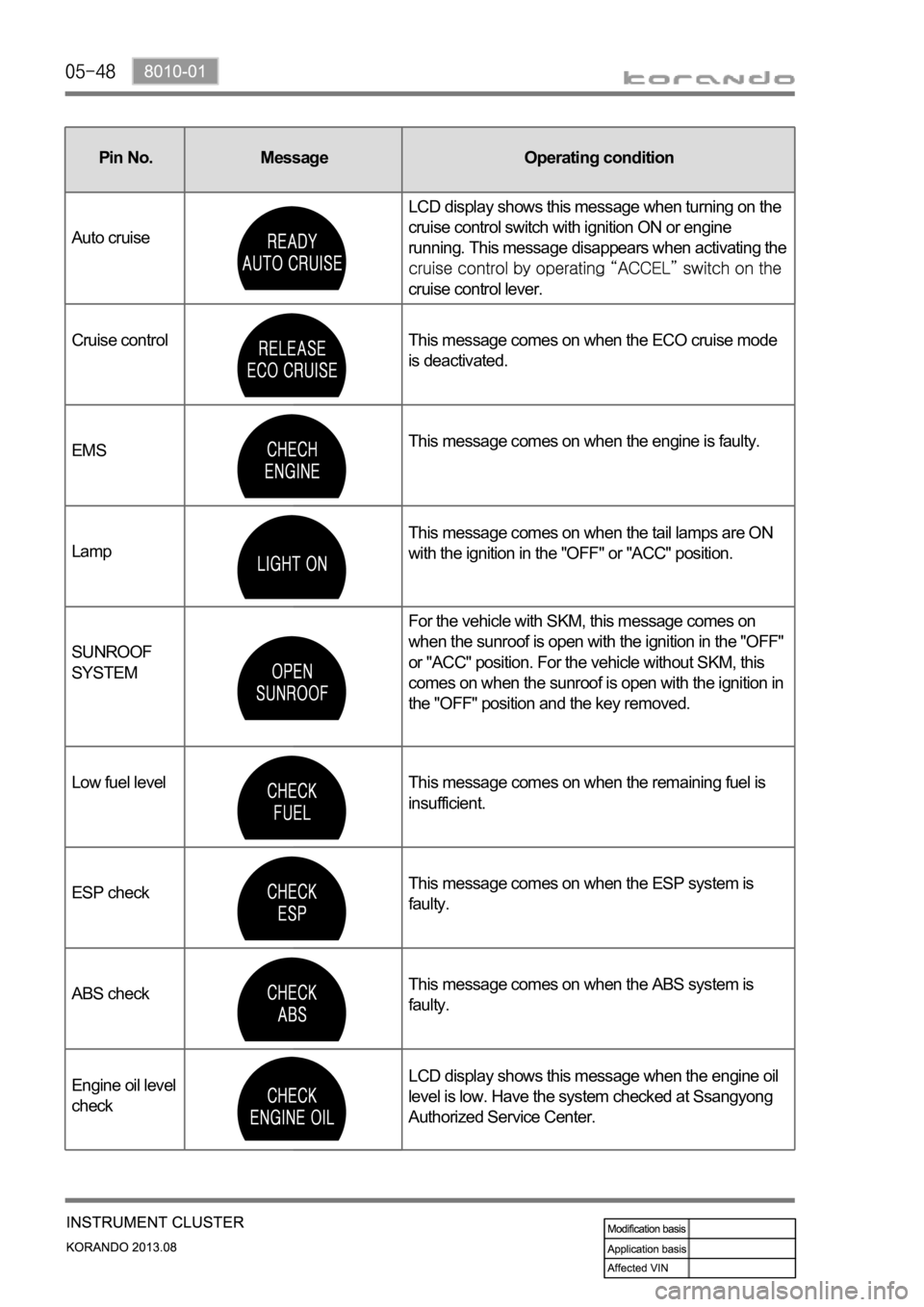
Pin No.Message
Operating condition
Domestic Export
Cruise control This message comes on when the ECO cruise mode
is deactivated.
EMSThis message comes on when the engine is faulty.
LampThis message comes on when the tail lamps are ON
with the ignition in the "OFF" or "ACC" position.
SUNROOF
SYSTEMFor the vehicle with SKM, this message comes on
when the sunroof is open with the ignition in the "OFF"
or "ACC" position. For the vehicle without SKM, this
comes on when the sunroof is open with the ignition in
the "OFF" position and the key removed.
Low fuel level This message comes on when the remaining fuel is
insufficient.
ESP checkThis message comes on when the ESP system is
faulty.
ABS check This message comes on when the ABS system is
faulty.
Engine oil level
checkLCD display shows this message when the engine oil
level is low. Have the system checked at Ssangyong
Authorized Service Center.Pin No. Message Operating condition
Auto cruiseLCD display shows this message when turning on the
cruise control switch with ignition ON or engine
running. This message disappears when activating the
cruise control lever.
Page 961 of 1336
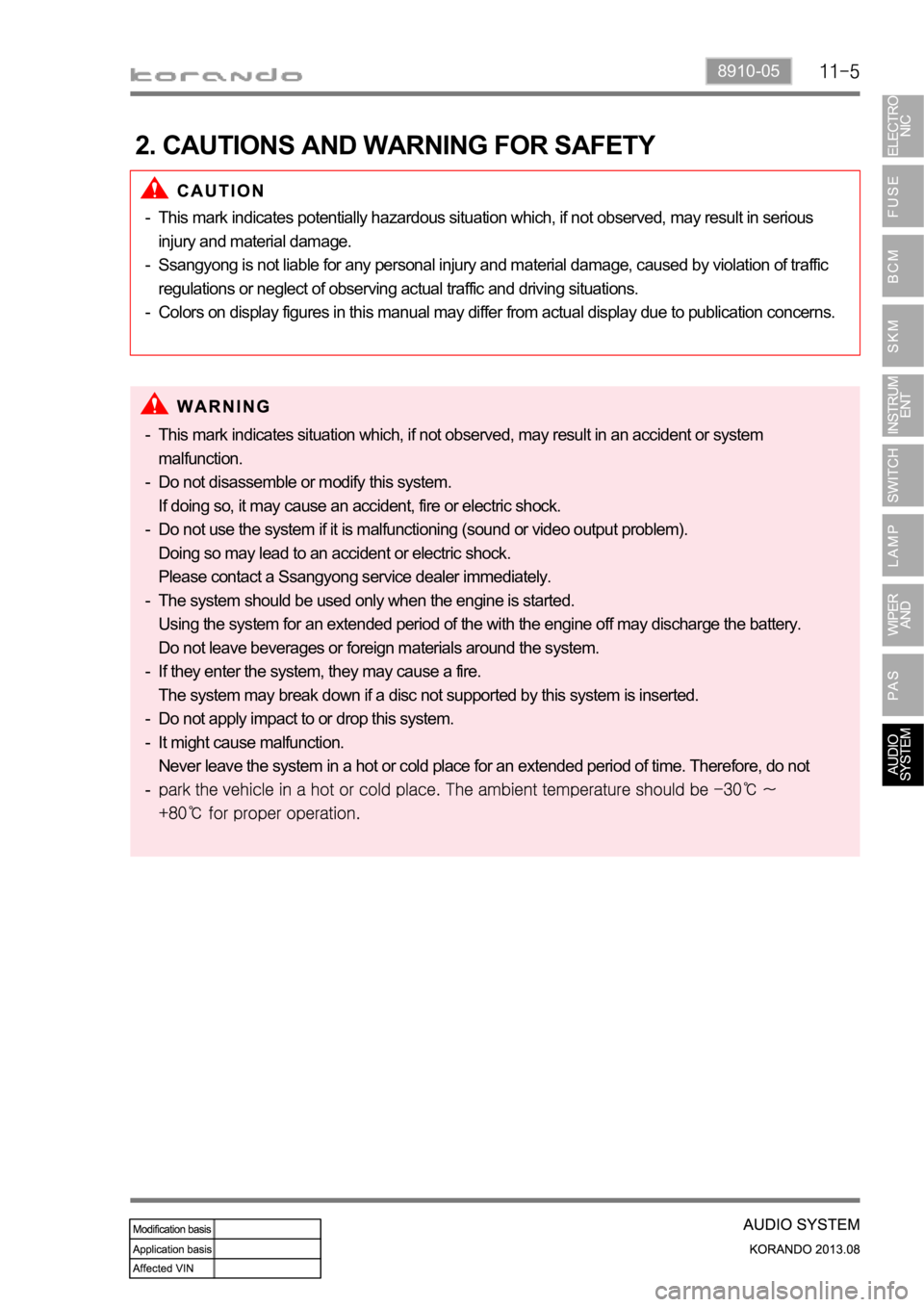
8910-05
2. CAUTIONS AND WARNING FOR SAFETY
This mark indicates potentially hazardous situation which, if not observed, may result in serious
injury and material damage.
Ssangyong is not liable for any personal injury and material damage, caused by violation of traffic
regulations or neglect of observing actual traffic and driving situations.
Colors on display figures in this manual may differ from actual display due to publication concerns. -
-
-
This mark indicates situation which, if not observed, may result in an accident or system
malfunction.
Do not disassemble or modify this system.
If doing so, it may cause an accident, fire or electric shock.
Do not use the system if it is malfunctioning (sound or video output problem).
Doing so may lead to an accident or electric shock.
Please contact a Ssangyong service dealer immediately.
The system should be used only when the engine is started.
Using the system for an extended period of the with the engine off may discharge the battery.
Do not leave beverages or foreign materials around the system.
If they enter the system, they may cause a fire.
The system may break down if a disc not supported by this system is inserted.
Do not apply impact to or drop this system.
It might cause malfunction.
Never leave the system in a hot or cold place for an extended period of time. Therefore, do not
-
-
-
-
-
-
-
-
Page 998 of 1336

1. GUIDELINES FOR SERVICE WORKS
1) For Safety
To perform the service works easily ans safely, the service technicians must keep the proper working
procedures and rules.
This manual provides the useful instructions to the service technicians so that they can perform the
servive works with standard working process, skills, tips in time.
Please read this manual and follow the instructions carefully.
indicates information to assist maintenance and instructions.
However, above references and cautions cannot be inclusive measures, so should have habits of
paying attentions and cautions based on common senses.
indicates a potentially hazardous situation which, if not avoided, may result in minor or moderate
injury or property damage.
indicates a potentially hazardous situation which, if not avoided, could result in death or serious
injury.
Page 999 of 1336
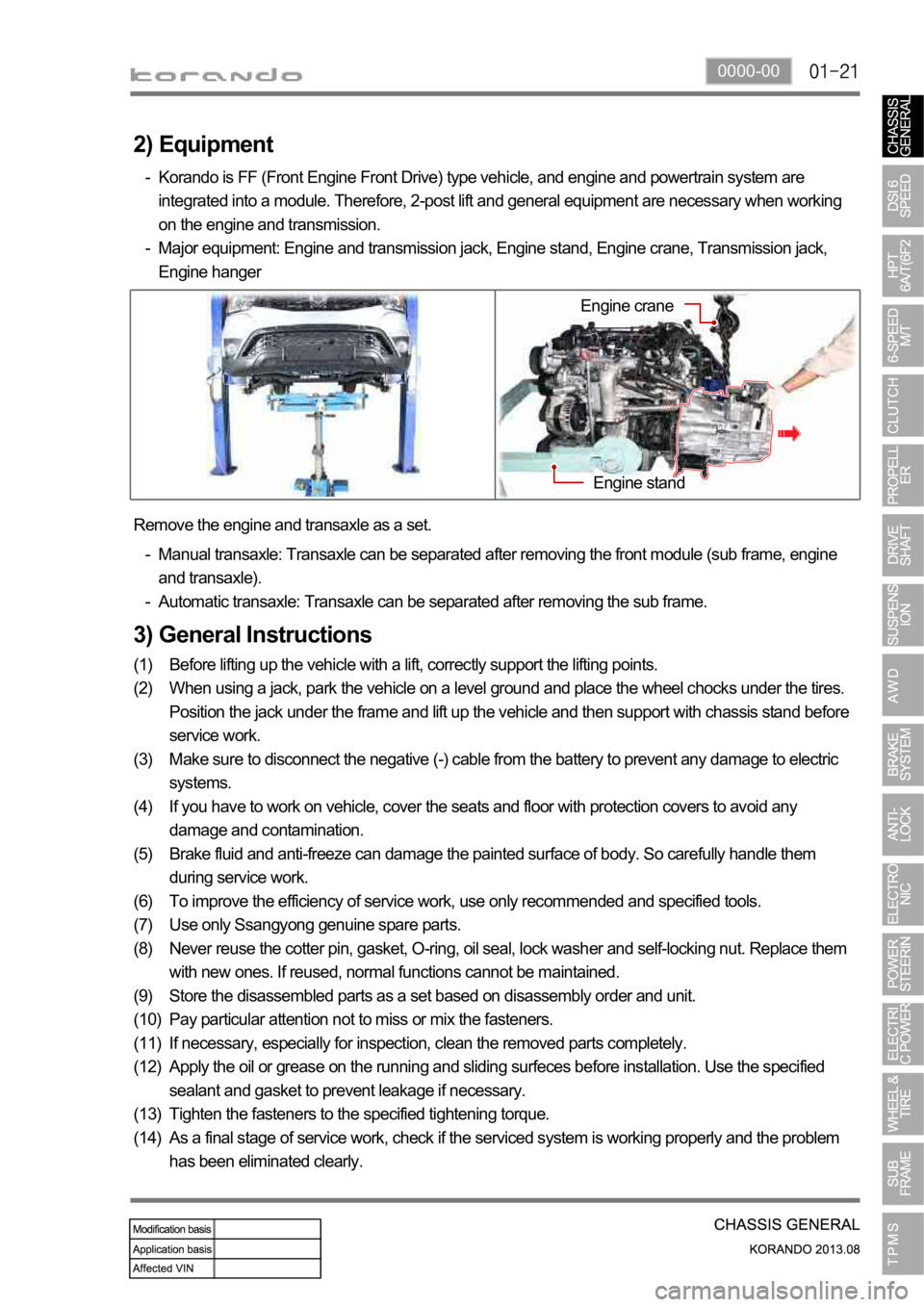
0000-00
3) General Instructions
Before lifting up the vehicle with a lift, correctly support the lifting points.
When using a jack, park the vehicle on a level ground and place the wheel chocks under the tires.
Position the jack under the frame and lift up the vehicle and then support with chassis stand before
service work.
Make sure to disconnect the negative (-) cable from the battery to prevent any damage to electric
systems.
If you have to work on vehicle, cover the seats and floor with protection covers to avoid any
damage and contamination.
Brake fluid and anti-freeze can damage the painted surface of body. So carefully handle them
during service work.
To improve the efficiency of service work, use only recommended and specified tools.
Use only Ssangyong genuine spare parts.
Never reuse the cotter pin, gasket, O-ring, oil seal, lock washer and self-locking nut. Replace them
with new ones. If reused, normal functions cannot be maintained.
Store the disassembled parts as a set based on disassembly order and unit.
Pay particular attention not to miss or mix the fasteners.
If necessary, especially for inspection, clean the removed parts completely.
Apply the oil or grease on the running and sliding surfeces before installation. Use the specified
sealant and gasket to prevent leakage if necessary.
Tighten the fasteners to the specified tightening torque.
As a final stage of service work, check if the serviced system is working properly and the problem
has been eliminated clearly. (1)
(2)
(3)
(4)
(5)
(6)
(7)
(8)
(9)
(10)
(11)
(12)
(13)
(14) Remove the engine and transaxle as a set.
Manual transaxle: Transaxle can be separated after removing the front module (sub frame, engine
and transaxle).
Automatic transaxle: Transaxle can be separated after removing the sub frame. -
-
2) Equipment
Korando is FF (Front Engine Front Drive) type vehicle, and engine and powertrain system are
integrated into a module. Therefore, 2-post lift and general equipment are necessary when working
on the engine and transmission.
Major equipment: Engine and transmission jack, Engine stand, Engine crane, Transmission jack,
Engine hanger -
-
Engine stand
Engine crane
Page 1015 of 1336
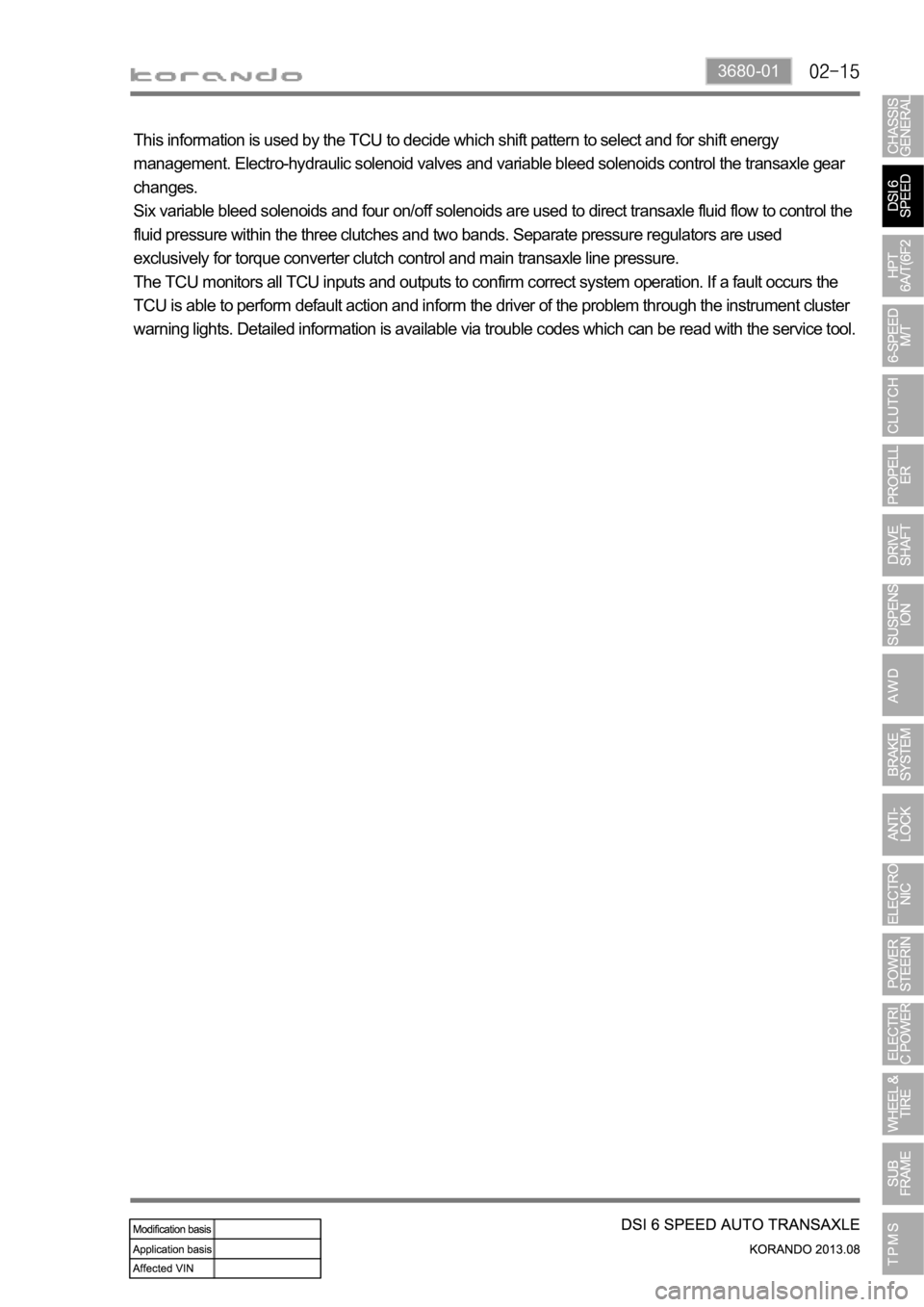
3680-01
This information is used by the TCU to decide which shift pattern to select and for shift energy
management. Electro-hydraulic solenoid valves and variable bleed solenoids control the transaxle gear
changes.
Six variable bleed solenoids and four on/off solenoids are used to direct transaxle fluid flow to control the
fluid pressure within the three clutches and two bands. Separate pressure regulators are used
exclusively for torque converter clutch control and main transaxle line pressure.
The TCU monitors all TCU inputs and outputs to confirm correct system operation. If a fault occurs the
TCU is able to perform default action and inform the driver of the problem through the instrument cluster
warning lights. Detailed information is available via trouble codes which can be read with the service tool.
Page 1036 of 1336

6. SPECIAL SERVICE TOLLS
Part number Name Tool How to use
00104-001(UD) Remover &
Installer - U/D
brake return sprin
00104-002(OD) Remover&
Installer - O/D
clutch return
spring
00104-003(LR)
(use with 00104-001)Remover&
Installer - L/R
brake return
spring
* Special service tool Supplier: Tool & Tech
Page 1043 of 1336
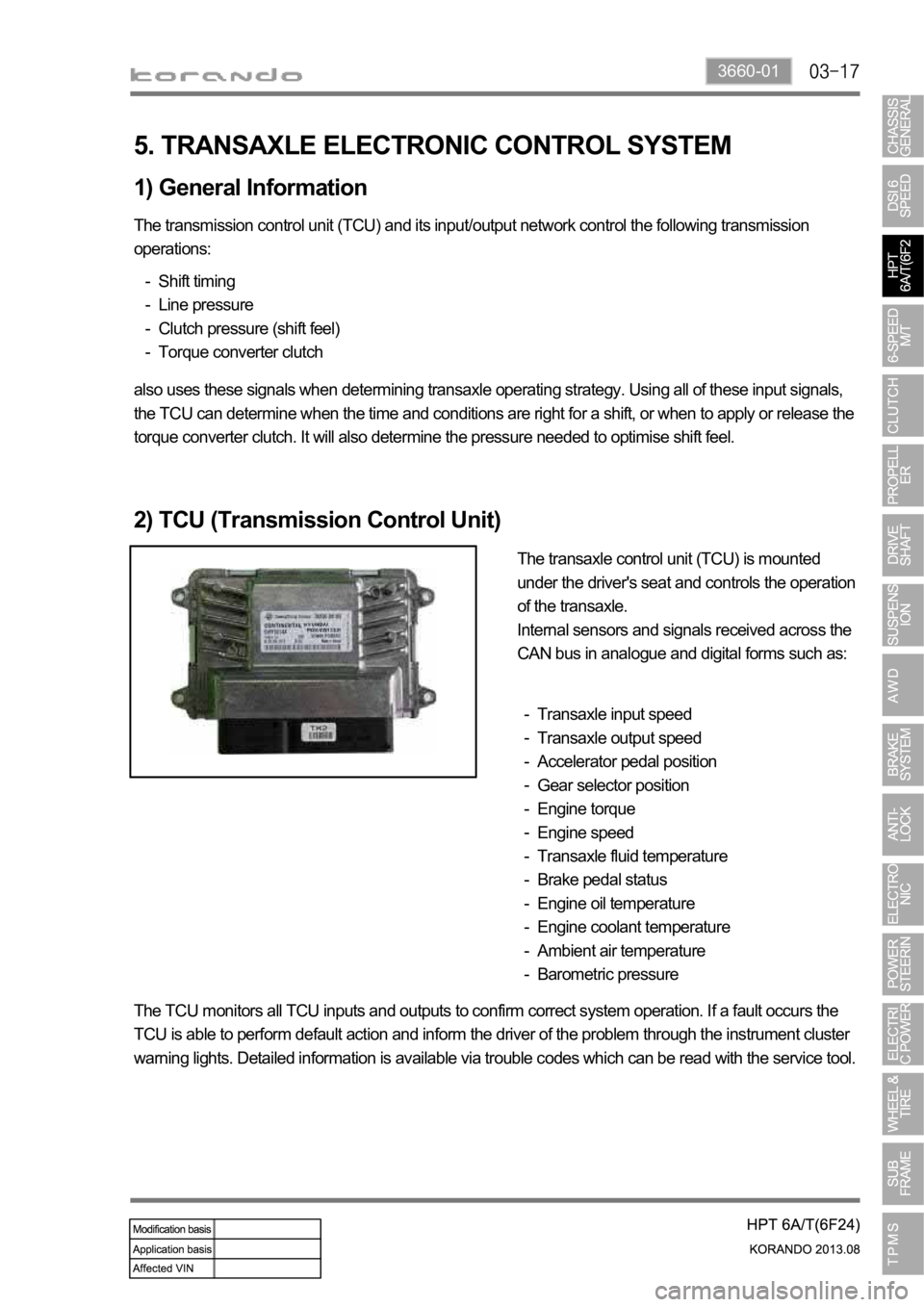
3660-01
5. TRANSAXLE ELECTRONIC CONTROL SYSTEM
1) General Information
The transmission control unit (TCU) and its input/output network control the following transmission
operations:
Shift timing
Line pressure
Clutch pressure (shift feel)
Torque converter clutch -
-
-
-
also uses these signals when determining transaxle operating strategy. Using all of these input signals,
the TCU can determine when the time and conditions are right for a shift, or when to apply or release the
torque converter clutch. It will also determine the pressure needed to optimise shift feel.
2) TCU (Transmission Control Unit)
The transaxle control unit (TCU) is mounted
under the driver's seat and controls the operation
of the transaxle.
Internal sensors and signals received across the
CAN bus in analogue and digital forms such as:
Transaxle input speed
Transaxle output speed
Accelerator pedal position
Gear selector position
Engine torque
Engine speed
Transaxle fluid temperature
Brake pedal status
Engine oil temperature
Engine coolant temperature
Ambient air temperature
Barometric pressure -
-
-
-
-
-
-
-
-
-
-
-
The TCU monitors all TCU inputs and outputs to confirm correct system operation. If a fault occurs the
TCU is able to perform default action and inform the driver of the problem through the instrument cluster
warning lights. Detailed information is available via trouble codes which can be read with the service tool.